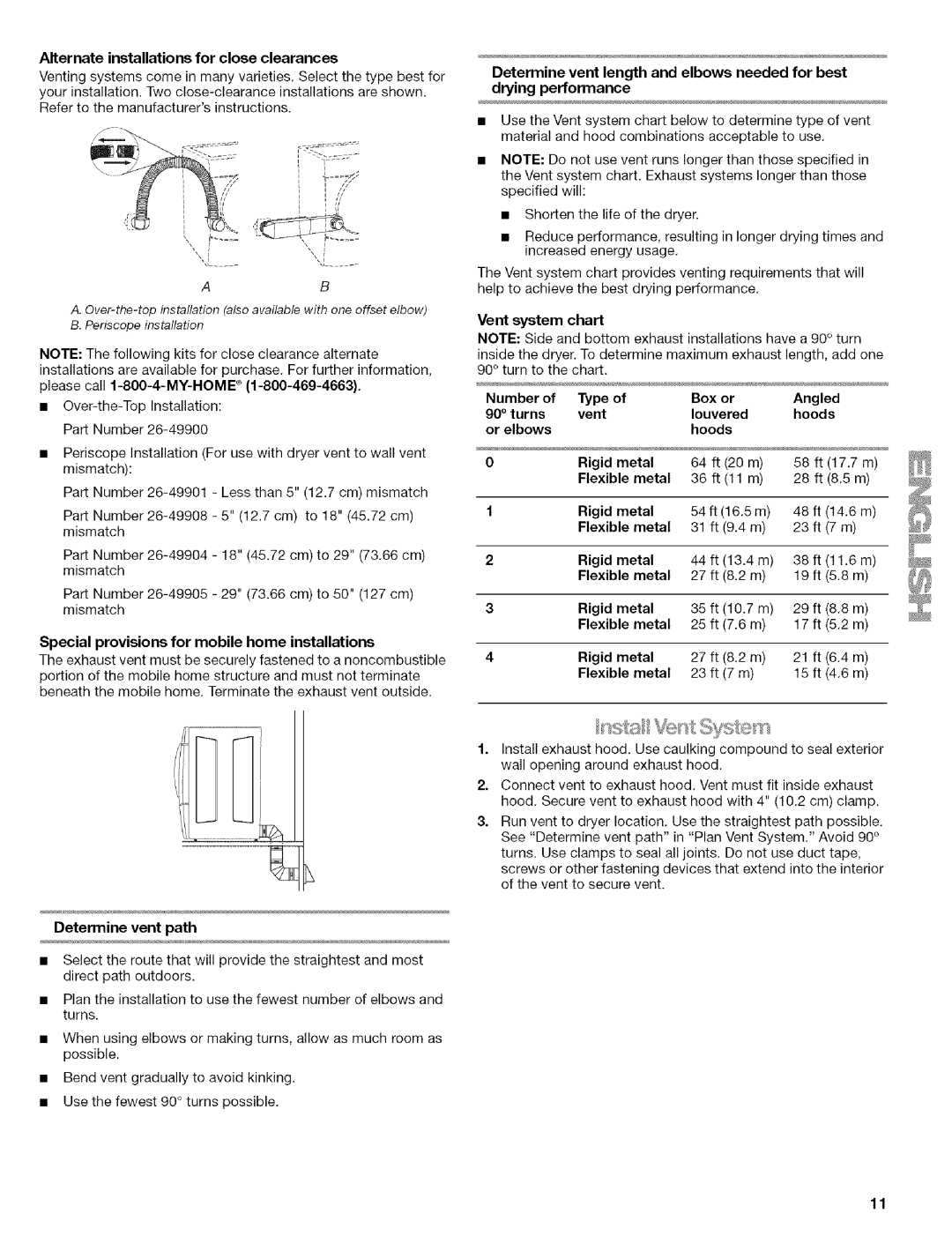
Alternate installations for close clearances
Venting systems come in many varieties. Select the type best for your installation. Two
f\\\
\
AB
A.
NOTE: The following kits for close clearance alternate installations are available for purchase. For further information, please call
•
•Periscope Installation (For use with dryer vent to wall vent mismatch):
Part Number
Part Number
Part Number
Part Number
Special provisions for mobile home installations
The exhaust vent must be securely fastened to a noncombustible portion of the mobile home structure and must not terminate beneath the mobile home. Terminate the exhaust vent outside.
Determine vent length and elbows needed for best drying performance
•Use the Vent system chart below to determine type of vent material and hood combinations acceptable to use,
•NOTE: Do not use vent runs longer than those specified in the Vent system chart. Exhaust systems longer than those specified will:
•Shorten the life of the dryer.
•Reduce performance, resulting in longer drying times and increased energy usage,
The Vent system chart provides venting requirements that will help to achieve the best drying performance,
Vent system chart
NOTE: Side and bottom exhaust installations have a 90 ° turn
inside the dryer. To determine maximum exhaust length, add one 90 ° turn to the chart.
Number of | Type of |
| Box or |
| Angled |
|
| ||||
90 ° turns | vent |
|
| Iouvered |
| hoods |
|
| |||
or elbows |
|
|
| hoods |
|
|
|
|
|
| |
0 | Rigid | metal | 64 | ft (20 m) | 58 | ft | (17.7 m) | ||||
| Flexible | metal | 36 | ft (11 m) | 28 | ft | (8.5 m) | ||||
1 | Rigid | metal | 54 ft (16.5 m) | 48 | ft | (14.6 | m) | ||||
| Flexible | metal | 31 | ft (9.4 | m) | 23 | ft | (7 m) |
| ||
2 | Rigid | metal | 44 | ft (13.4 m) | 38 | ft | (11.6 | m) | |||
| Flexible | metal | 27 | ft (8.2 | m) | 19 ft | (5.8 | m) | |||
3 | Rigid | metal | 35 | ft (10.7 m) | 29 | ft | (8,8 | m) | |||
| Flexible | metal | 25 | ft (7.6 | m) | 17 ft | (5,2 | m) | |||
4 | Rigid | metal | 27 | ft (8,2 | m) | 21 | ft | (6.4 | m) | ||
| Flexible | metal | 23 | ft (7 m) | 15 ft | (4,6 | m) | ||||
1. Install exhaust hood. Use caulking compound to seal exterior wall opening around exhaust hood.
2. Connect vent to exhaust hood. Vent must fit inside exhaust hood. Secure vent to exhaust hood with 4" (10.2 cm) clamp.
3. Run vent to dryer location. Use the straightest path possible. See "Determine vent path" in "Plan Vent System." Avoid 90 ° turns. Use clamps to seal all joints. Do not use duct tape, screws or other fastening devices that extend into the interior of the vent to secure vent.
Determine vent path
•Select the route that will provide the straightest and most direct path outdoors.
•Plan the installation to use the fewest number of elbows and turns.
•When using elbows or making turns, allow as much room as possible.
•Bend vent gradually to avoid kinking.
•Use the fewest 90 ° turns possible,
11
